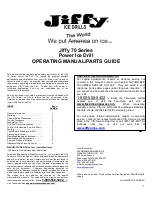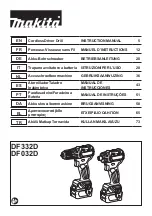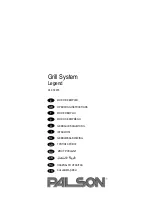
7
1. GENERAL SAFETY RULES
WARNING: Read and understand all instructions. Failure to follow all instructions listed below may
result in electric shock, fire and/or serious personal injury. SAVE THESE INSTRUCTIONS
Work Area
1. Keep your work area clean and well lit. Cluttered benches and dark areas invite accidents.
2. Do not operate power tools in explosive atmospheres, such as in the presence of flammable
liquids, gases, or dust. Power tools create sparks which may ignite the dust or fumes.
3. Keep bystanders, children, and visitors away while operating a power tool. Distractions can cause
you to lose control.
Electrical Safety
4. A battery operated tool with integral batteries or a separate battery pack must be recharged only
with the specified charger for the battery. A charger that may be suitable for one type of battery may
create a risk of fire when used with another battery.
5. Use battery operated tool only with specifically designated battery pack. Use of any other batte-
ries may create a risk of fire.
Personal Safety
6. Stay alert, watch what you are doing, and use common sense when operating a power tool. Do
not use tool while tired or under the influence of drugs, alcohol, or medication. A moment of inatten-
tion while operating power tools may result in serious personal injury.
7. Dress properly. Do not wear loose clothing or jewelry. Contain long hair. Keep your hair, clothing,
and gloves away from moving parts. Loose clothes, jewelry, or long hair can be caught in moving
parts.
8. Avoid accidental starting. Be sure switch is in the locked or off position before inserting battery
pack. Carrying tools with your finger on the switch or inserting the battery pack into a tool with the
switch on invites accidents.
9. Do not overreach. Keep proper footing and balance at all times. Proper footing and balance
enable better control of the tool in unexpected situations.
10. Use safety equipment. Always wear eye protection. Dust mask, non-skid safety shoes, hard hat,
or hearing protection must be used for appropriate conditions.
Tool Use and Care
11. Use clamps or other practical way to secure and support the workpiece to stable platform.
Holding the work by hand or against your body is unstable and may lead to loss of control.
12. Do not force tool. Use the correct tool for your application. The correct tool will do the job better
and safer at the rate for which it is designed.
13. Do not use tool if switch does not turn it on or off. A tool that cannot be controlled with the
switch is dangerous and must be repaired.
14. Disconnect battery pack from tool or place the switch in the locked or off position before making
any adjustments, changing accessories, or storing the tool. Such preventive safety measures
reduce the risk of starting the tool accidentally.
15. Store idle tools out of reach of children and other untrained persons. Tools are dangerous in the
hands of untrained users.
16. When battery pack is not in use, keep it away from other metal objects like: paper clips, coins,
keys, nails, screws, or other small metal objects that can make a connection from one terminal to
another. Shorting the battery terminals together may cause sparks, burns, or a fire.
17. Maintain tools with care. Properly maintained tools with sharp cutting edge are less likely to bind
and are easier to control.
18. Check for misalignment or binding of moving parts, breakage of parts, and anyother condition
that may affect the tool’s operation. If damaged, have the tool serviced before using. Many acci-
dents are caused by poorly maintained tools.
19. Use only accessories that are recommended by the manufacturer for yourmodel. Accessories
that may be suitable for one tool may create a risk of injury when used on another tool.
SERVICE
20. Tool service must be performed only by qualified repair personnel. Service or maintenance
performed by unqualified personnel may result in a risk of injury.
21. When servicing a tool, use only identical replacement parts. Follow instructions in the Mainte-
nance section of this manual. Use of unauthorized parts or failure to follow Maintenance instructions
may create a risk of shock or injury.
SPECIFIC SAFETY RULES
1. Hold tool by insulated gripping surfaces when performing an operation where the drilling tool may
contact hidden wiring. Contact with a “live” wire will also make exposed metal parts of the tool “live”
and shock the operator.
2. Be aware that this tool is always in an operating condition, because it does not have to be plug-
ged into an electrical outlet.
3. Always be sure you have a firm footing.
4. Be sure no one is below when using the tool in high locations.
5. Hold the tool firmly.
6. Keep hands away from rotating parts.
7. Do not leave the tool running. Operate the tool only when hand-held.
8. Do not touch the drill bit or the workpiece immediately after operation; they may be extremely hot
and could burn your skin.
9. Some material contains chemicals which may be toxic. Take caution to prevent working dust
inhalation and skin contact.
Follow material supplier safety data.
SAVE THESE INSTRUCTIONS
WARNING: MISUSE or failure to follow the safety rules stated in this instruction manual may cause
serious personal injury.
SAFETY INSTRUCTIONS FOR CHARGER & BATTERY CARTRIDGE
1. SAVE THESE INSTRUCTIONS - This manual contains important safety and operating instructions
for battery charger.
2. Before using battery charger, read all instructions and cautionary markings on(1) battery charger,
(2) battery, and (3) product using battery.
3. CAUTION - To reduce risk of injury, charge only Vimax rechargeable batteries marked on the
charger label. Other types of batteries may burst causing personal injury and damage.
4. Do not expose charger to rain or snow.
5. Use of an attachment not recommended or sold by the battery charger manufacturer may result
in a risk of fire, electric shock, or injury to persons.
6. To reduce risk of damage to electric plug and cord, pull by plug rather than cord when disconnec-
ting charger.
7. Make sure cord is located so that it will not be stepped on, tripped over, or otherwise subjected to
damage or stress.
8. Do not operate charger with damaged cord or plug - replace them immediately.
9. Do not operate charger if it has received a sharp blow, been dropped or otherwise damaged in
any way; take it to a qualified serviceman.
10. Do not disassemble charger or battery cartridge; take it to a qualified serviceman when service
or repair is required, Incorrect reassembly may result in a risk of electric shock or fire.
11. To reduce risk of electric shock, unplug charger from outlet before attempting any maintenance
or cleaning. Turning off controls will not reduce this risk.
12. The battery charger is not intended for use by young children or infirm persons without supervi-
sion.
13. Young children should be supervised to ensure that they do not play with the battery charger.
14. If operating time has become excessively shorter, stop operating immediately. It may result in a
risk of overheating, possible burns and even an explosion.
15. If electrolyte gets into your eyes, rinse them out with clear water and seek medical attention right
away. It may result in loss of your eyesight.
2. ADDITIONAL SAFETY RULES FOR CHARGER & BATTERY CARTRIDGE
1. Do not charge Battery Cartridge when temperature is BELOW 10°C (50°F) or ABOVE 40°C (104°F).
2. Do not attempt to use a step-up transformer, an engine generator or DC power receptacle.
3. Do not allow anything to cover or clog the charger vents.
4. Always cover the battery terminals with the battery cover when the battery cartridge is not used.
5. Do not short the battery cartridge:
(1) Do not touch the terminals with any conductive material.
(2) Avoid storing battery cartridge in a container with other metal objects such as nails, coins, etc.
(3) Do not expose battery cartridge to water or rain. A battery short can cause a large current flow,
overheating, possible burns and even a breakdown.
6. Do not store the tool and Battery Cartridge in locations where the temperature may reach or
exceed 50°C (122°F).
7. Do not incinerate the Battery Cartridge even if it is severely damaged or is completely worn out.
The battery cartridge can explode in a fire.
8. Be careful not to drop, shake or strike battery.
9. Do not charge inside a box or container of any kind. The battery must be placed in a well ventila-
ted area during charging.
5. FUNCTIONAL DESCRIPTION
CAUTION:
• Always be sure that the tool is switched off and the battery cartridge is removed before adjusting
or checking function on the tool.
Installing or removing battery cartridge
• Always switch off the tool before insertion or removal of
the battery cartridge.
• To remove the battery cartridge, withdraw it from the tool while
pressing the buttons on both sides of the cartridge.
• To insert the battery cartridge, align the tongue on the
battery cartridge with the groove in the housing and slip it into
place. Always insert it all the way until it locks in place with a little
click. If not, it may accidentally fall out of the tool, causing injury to
you or someone around you.
• Do not use force when inserting the battery cartridge. If the cartridge does
not slide in easily, it is not being inserted correctly.
Charging
1. Plug the battery charger into the proper AC voltage source. The charging light will flash in green
color.
2. Insert the battery cartridge so that the plus and minus terminals on the battery cartridge are on
the same sides as their respective markings on the charger. Insert the cartridge fully into the port so
that it rests on the charger port floor.
3. When the battery cartridge is inserted, the charging light color will change from green to red and
charging will begin. The charging light will remain lit steadily during charging.
4. When the charging light color changes from red to green, the charging cycle is complete.
5. If you leave the battery cartridge in the charger after the charging cycle is complete, the charger
will switch into its “trickle charge (maintenance charge)” mode.
6. After charging, unplug the charger from the power source.
NOTE:
• The battery charger is for charging Vimax battery cartridge. Never use it for other purposes or for
other manufacturer’s batteries.
• When you charge a new battery cartridge or a battery cartridge which has not been used for a
long period of time, it may not accept a full charge. This is a normal condition and does not indicate
a problem. You can recharge the battery cartridge fully after discharging it completely and rechar-
ging a couple of times.
• If you charge a battery cartridge from a just operated tool or a battery cartridge which has been
left in a location exposed to direct sunlight or heat for a long time, the charging light may flash in red
color. If this occurs, wait for a while. Charging will begin after the battery cartridge cools. The
battery cartridge will cool faster if you remove the battery cartridge from the battery charger.
• If the charging light flashes alternately in green and red color, charging is not possible. The termi-
nals on the charger or battery cartridge are clogged with dust or the battery cartridge is worn out or
damaged.
Tips for maintaining maximum battery life
1. Charge the battery cartridge before completely discharged. Always stop tool operation and
charge the battery cartridge when you notice less tool power.
2. Never recharge a fully charged battery cartridge. Overcharging shortens the battery service life.
3. DESCRIPTION
3. Charge the battery cartridge with room temperature at 10°C - 40°C (50°F - 104°F).Let a hot
battery cartridge cool down before charging it.
4. Charge the Nickel Metal Hydride battery cartridge when you do not use it for more than six
months.
Switch action
CAUTION:
• Before inserting the battery cartridge into the tool, always check to see that the switch trigger
actuates properly and returns to the “OFF” position when released.
To start the tool, simply pull the switch trigger. Tool speed is increased by increasing pressure on
the switch trigger. Release the switch trigger to stop.
Reversing switch action
This tool has a reversing switch to change the direction of rotation. Depress the reversing switch
lever from the A side for clockwise rotation or from the B side for counterclockwise rotation.
When the reversing switch lever is in the neutral position, the switch trigger cannot be pulled.
CAUTION:
• Always check the direction of rotation before operation.
• Use the reversing switch only after the tool comes to a complete stop. Changing the direction of
rotation before the tool stops may damage the tool.
• When not operating the tool, always set the reversing switch lever to the neutral position.
Speed change
To change the speed, first switch off the tool and then
slide the speed change lever to the "2" side for high speed
or "1" side for low speed. Be sure that the speed change
lever is set to the correct position before operation.
Use the right speed for your job.
CAUTION:
• Always set the speed change lever fully to the correct position. If you operate the tool with the
speed change lever positioned halfway between the "1" side and "2" side, the tool may be dama-
ged.
• Do not use the speed change lever while the tool is running. The tool may be damaged.
Adjusting the fastening torque
The fastening torque can be adjusted in 20 steps by turning
the adjusting ring so that its graduations are aligned with the
pointer on the tool body. The fastening torque is minimum
when the number 1 is aligned with the pointer 20, and
maximum when the marking is aligned with the pointer.
The clutch will slip at various torque levels when set at the
number 1 to 20. Before actual operation, drive a trial screw
into your material or a piece of duplicate material to
determine which torque level is required for a particular application.





























